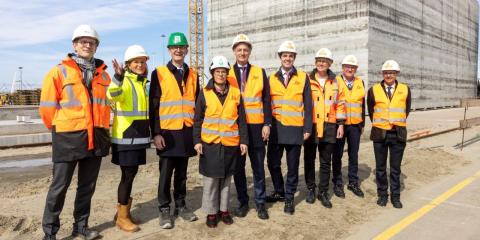Belgian ministers visit construction site for Princess Elisabeth Island

Each caisson takes around 3 months to build
Work began in Flushing in September 2023, with around 300 staff employed on site each day. As the first caisson nears completion, the scale of the project is becoming truly apparent for the first time. Each concrete block measures 57 m in length, 30 m in width and 30 m in height, and weighs 22,000 tonnes. It takes approximately three months to build one caisson. The production process is split into five stages, each lasting 20 days. The caissons are moved between the different work sites using 'runners', which takes about six hours. The most impressive construction phase is the second, in which slipforming is used to create the caisson walls. Ten centimetres are added every hour over a period of around ten days.
23 caissons for one island
When the caissons are ready, a semi-submersible vessel will transport them further down the harbour, where they will be placed in the water and temporarily stored. They will then be moved to their final location in the North Sea this summer (weather permitting). The caissons will form the outer walls of the energy island. The island itself will be created using approximately 2.3 million m³ of sand, extracted locally. The island will be finished in late 2026, when the electrical equipment can start to be installed. Contracts for this will be tendered this year.
The energy island is being partly financed by the EU's COVID-19 recovery fund, having been awarded a grant of around €100 million, in consultation with the Belgian government. Both Belgian and European support has also been pledged to implement a series of nature measures. In consultation with conservation and marine environment experts, a nature-inclusive design has been developed that will enhance biodiversity on and around the island.
A feat of innovation
Princess Elisabeth Island will be the first artificial energy island in the world to combine both direct current (HVDC) and alternating current (HVAC). The high-voltage infrastructure on the island will bundle together the electricity cables from the wind farms in the Princess Elisabeth Zone. The island will also become a hub for future interconnectors. In fact, these 'hybrid' interconnectors will have two functions, leading to enhanced efficiency. Not only will they handle power exchanges between countries, but they will also be connected to new offshore wind farms in the northern part of the North Sea that will eventually supply Belgium with large quantities of green electricity.
Alexander De Croo, Prime Minister of Belgium: "The North Sea is set to become the powerhouse of our energy independence, and Princess Elisabeth Island will be a crucial part of this process. Belgium has long been a pioneer in offshore wind, and by continuing to innovate, we are further consolidating our position for the future. This gives our Belgian companies more opportunity to do groundbreaking work, both here and abroad, as well as guaranteeing sustainable, competitively priced energy for our citizens and businesses. Once again, we are putting Belgium on the map."
Tinne Van der Straeten, Federal Minister for Energy: "Our offshore expertise is now world-renowned. As well as technical knowledge and expertise, Princess Elisabeth Island is also a fine example of participation. It is the first project of its size to take biodiversity into account from the outset, and to do so in consultation with experts in the field. Belgium has shown that renewable energy and biodiversity go hand in hand, and is thereby setting the standard for many future projects in the North Sea, the centre of Europe's ambitions for offshore wind power."
Thomas Dermine, State Secretary for Economic Recovery and Strategic Investments: "The energy island is a flagship project for the Recovery Plan and embodies three of its defining features: investment in infrastructure, deployment of innovative solutions and acceleration of the ecological transition. The project also illustrates the Recovery Plan's dynamic approach: it will haven taken six years to get from the conceptual phase to full completion, which is quite an achievement for a project of this size."
Catherine Vandenborre, Interim CEO, Elia Group: "The energy island is of strategic importance for the energy transition in Belgium. As well as opening up the second offshore wind zone, the island concept also provides important options for the future. It will be the first energy hub in the North Sea that is connected via interconnectors to wind farms from other countries that have a surplus of renewable energy. Access to massive volumes of sustainable and cheap electricity is important for the competitiveness of our industry and the prosperity of our households."
Julie De Nul, CEO, Jan De Nul Group: "As CEO of Jan De Nul Group, I am particularly proud of the construction of these caissons. They will soon be out at sea, forming the contours of the world's very first artificial energy island. This is a powerful example of co-building the energy transition on water and land, and a big step towards a sustainable future. That is something that we at Jan De Nul Group and as a team at TM Edison and Elia are very passionate about."
Luc Vandenbulcke, CEO, DEME Group: "The close collaboration between the TM Edison and Elia teams over the past few months has led to significant progress in realising the world's first energy island. While construction of the caissons is in full swing, offshore work has also started to enable the installation of these caissons at sea. This unique project, which combines innovative technology with a nature-inclusive design, offers Belgian companies such as DEME another opportunity to demonstrate our pioneering role and expertise in building infrastructure that supports the energy transition."